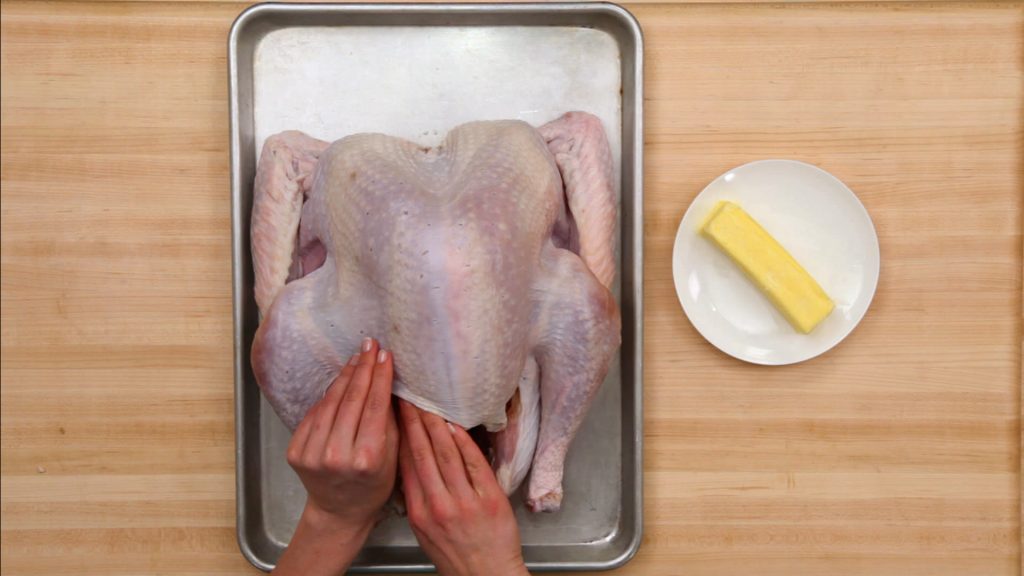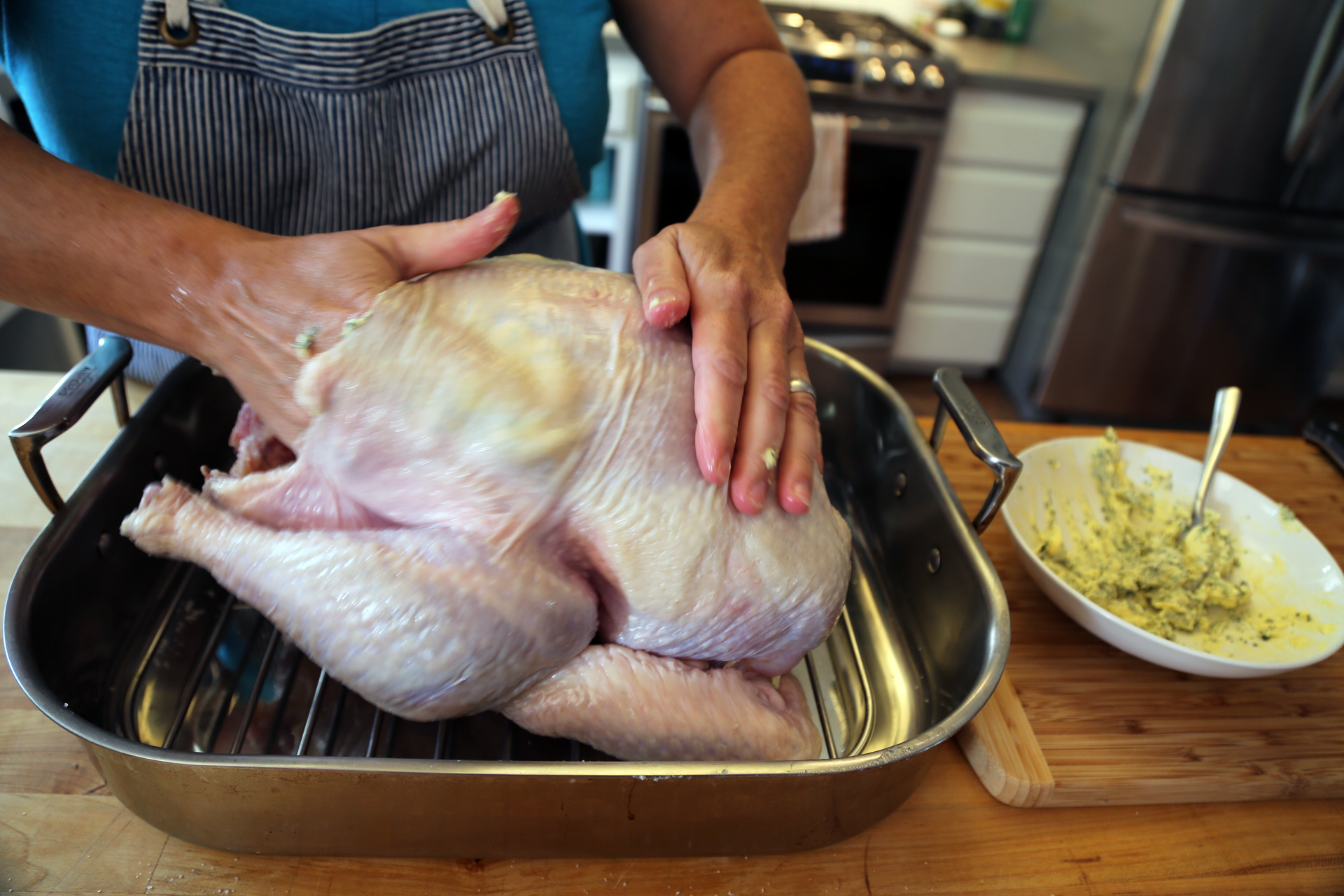As Thanksgiving approaches, turkey roasters everywhere are pondering that timeless question should I rub butter under the skin of my turkey? Generations of cooks have used this trick to achieve a crispy skin and moist, flavorful meat. But is it really necessary? Does the added fat make your holiday bird more decadent or just plain greasy?
Before slicking up your bird, let’s examine the benefits and drawbacks of using butter underneath the skin. With this knowledge you can make an informed decision about the best preparation for your Thanksgiving turkey.
Why Put Butter Under Turkey Skin?
Here are some of the main advantages of rubbing butter under the skin:
- Moisture – As the butter melts during roasting, it bastes the meat and helps keep it tender and juicy. The fat acts as a barrier against drying out.
- Flavor – Butter adds richness and a lovely savory quality. Herb butters can provide even more complex flavors.
- Browning – The milk solids in butter promote gorgeous browning through caramelization and Maillard reactions.
- Crisp skin – Butter helps crisp the skin by causing it to shrink from the subcutaneous fat layer.
So butter underneath the skin clearly provides some benefits. But how necessary is it?
Consider Drawbacks of Adding Butter
Slathering butter adds significant fat and calories. Each tablespoon contributes 100 calories and 11 grams of fat. A 16-pound turkey can absorb a full cup of butter or more!
Too much butter pooling under the skin may also lead to issues:
- Uneven cooking – Thick areas of butter cook more slowly.
- Soggy skin – Butter can weigh down the skin and inhibit crisping.
- Greasy texture – Too much fat can create a greasy mouthfeel.
- Blunted flavor – An overpowering butter taste may mask the delicate turkey flavor.
So while butter adds moisture and flavor, excessive amounts can make your holiday bird greasy and lead to uneven cooking. Moderation is key.
Achieve Best Results with a Moderate Amount
For the benefits of butter without the drawbacks, use a moderate amount under the skin. Follow these tips:
- Use 3-4 tablespoons total for a 12-15 lb turkey.
- Refrigerate butter first so it spreads evenly without melting immediately.
- Loosen skin carefully without tearing it so butter coats all meat areas.
- Sprinkle salt and herbs under the skin along with the chilled butter.
- Brush skin with olive oil before roasting to boost browning.
- Roast at 425°F for crispy skin, then drop to 325°F once browned.
With the right balance of flavorful butter inside and crisping oil outside, your turkey will turn out moist, tender, and golden brown without being greasy.
Alternatives to Spreading Butter Under Skin
If you wish to avoid butter altogether, alternatives like olive oil, chicken stock, or herb paste can add moisture and flavor under the turkey skin:
- Olive oil – Has a high smoke point so won’t burn like butter. Adds moisture without strong flavor.
- Chicken stock – Provides a savory flavor and keeps meat juicy. Opt for low-sodium stock.
- Herb paste – Chopped herbs, oil, spices, and zest make a flavorful rub.
- Citrus – Slices of orange or lemon infuse bright flavor.
- Aromatics – Stuff neck cavity with onion, celery, garlic, and herbs.
With a little creativity, you can achieve a succulent bird without slathering on the butter.
While generations of cooks may swear by butter under the skin, alternatives can also do the trick. Use the method that best fits your preferences and health priorities. With the right prep, your turkey will turn out moist and full of flavor either way. Here’s to a very happy Thanksgiving!
FAQ
Do I need to put butter under turkey skin?
Should I rub butter on my turkey before smoking?
Do Butterball turkeys have butter under the skin?
Can you put butter under a Turkey skin?
Using butter under the skin of your turkey can be a great way to keep the meat moist and add flavor. However, it can also lead to a not-so-crispy skin, which is not ideal for many people. Here are some tips to ensure your turkey still has a crispy skin: Firstly, make sure the butter is not too soft when you spread it under the skin.
What are the best substitutes for butter?
The substitute that you might want to use depends on what you are using butter for. In baking you can use any fat such as olive oil, nut butters, or even avocados. In baking you can also substitute non-fats for butter such as Greek yogurt, mashed bananas, pumpkin puree, or even applesauce. For replacing butter as a spread, you can use any fat, hummus, avocado, nut butter, or cheese. For cooking, canola oil can be a great sub, or avocado oil is also good because it has a high smoke point.
Can you put butter under a turkey breast?
Just really carefully work your hand under there, you don’t wanna poke through the skin. Otherwise, once the turkey is roasting, all that moisture is going to escape. And what you’re doing here is you’re creating little pockets so that once you put the butter in there, it can spread all over. After you’ve loosened up the skin on both breasts,
Should you butter a Turkey before cooking?
Butter may cause the skin to brown unevenly, so rubbing down the exterior of the turkey with olive oil will yield a better result. For some extra convenience, you can easily butter your turkey the night before you need to cook it!
What is herb butter Turkey under skin?
A: Herb butter turkey under skin is a simple and delicious way to cook a turkey. The herb butter is rubbed under the skin of the turkey, which helps to keep the meat moist and flavorful. This method of cooking is also very easy, as it does not require any special equipment or techniques.
What kind of butter do you put in a Turkey?
When it comes to flavor options, there are a few choices to consider. Traditional salted butter adds a savory richness to the turkey, enhancing its natural flavors. If you prefer a more herb-infused taste, you can opt for garlic or herb butter. These variations can give your turkey a delightful aromatic twist.

